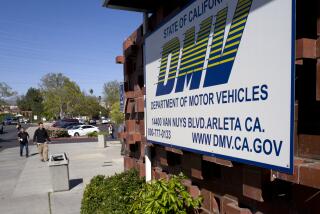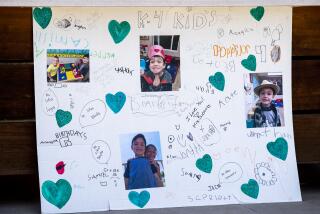Accidents Up for Teen Girls
- Share via
Natalie Finegood was running late and facing a test at high school.
So she put a list of vocabulary words on her lap and started taking advantage of traffic signals to cram.
She wasn’t watching the lights, so when she heard the other cars around her at an intersection accelerate, she did the same.
One small problem: With eyes focused on the vocabulary list instead of the road, she failed to notice a slow-moving vehicle directly ahead of her.
“I rear-ended a trash truck,” says Finegood, now 17, describing the accident that occurred in July 2000 when she had had her driver’s license for just four months.
Finegood’s 1994 Ford Explorer was fixable and no one was hurt. And the accident, she says, “made me more aware of events on the road.” With the exception of a speeding ticket, she’s driven without incident since the accident.
The Los Angeles teen’s driving record reflects a troubling nationwide statistic: The youngest female drivers are crashing more often. Although their accident rates don’t yet match those of teenage boys, safety experts and parents view the trend as disturbing.
Exactly why teen girls are becoming riskier drivers is a matter of debate--some experts blame movie and TV portrayals of aggressive driving, some say it’s simply that teen girls now drive more miles than in the past, and others insist that the new statistics are but a blip on the radar screen and that girls’ accident rates are heading back down.
But for now there’s an upward trend.
In 1990, 16% of 16-year-old girl drivers were involved in traffic accidents, according to statistics from the Insurance Institute for Highway Safety, an independent organization funded by auto insurers.
By 2000, the figure was 17.5%. In the same period, the percentage of 16-year-old boys involved in accidents dropped from 21.6% to 21%, says safety institute spokesman Russ Rader.
Traditionally, teen males have paid higher auto insurance premiums than teen females, reflecting their higher risk. But that gap is closing. In 1985, male drivers ages 16 to 20 paid 61% higher premiums than females in the same age range, says Dick Luedke, a spokesman for State Farm Insurance Co.
By 2000, the difference was down to 41%.
But Luedke says most of the increase in females’ premiums occurred between 1985 and 1995 and that the rate of increase may be leveling off.
Some experts say there’s a practical explanation for the increased accident rate among young females: They’re are simply driving more miles than they used to. That trend is expected to continue.
In 1977, licensed female drivers ages 16 to 19 drove an average of 4,036 miles a year, Rader says. By 1995, the national average annual mileage among the same age group was 6,870 miles. (If this sounds low to Southern California parents, Rader points out that it is a national average and that teen drivers from smaller cities and rural towns pull down the average considerably.)
Other driving experts say there’s more to the rise in risky female driving than mileage alone.
Media and culture that promote a new, more aggressive female also are to blame, says Leon James, professor of psychology at the University of Hawaii and a veteran researcher of road rage and other driving behavior.
The aggression portrayed in car chases and other common scenes, he says, is imitated by teens of both genders.
The type of vehicle driven may also affect driving behavior and, in turn, crash rates, James says. In his surveys, he has found those who drive SUVs and sports cars say they feel more aggression than did drivers of other vehicles.
Even more troubling, he says, is that the drivers of these vehicles have told him that driving aggressively made them feel more competent as drivers.
Jeffrey Arnett, an independent scholar affiliated with the University of Maryland who has studied teen behavior extensively, takes issue with what he calls the media’s habit of romanticizing driving risk.
A prime example, he says, are car commercials that emphasize a vehicle’s speed. Other factors that might influence the rising crash rate of young female drivers, Arnett says, is socialization that includes “less pressure to be girly.”
And some risky driving behavior, he adds, is associated with immaturity, not gender.
“Both boys and girls in this age group take more risk,” Arnett says. “They incur infractions for such behaviors as speeding.”
Arnett, like the other experts, points out that boys remain the riskiest young drivers.
Driver education and traffic school instructors agree.
“Boys are more aggressive [drivers] than girls,” says Elizabeth Lomer, operator of the Ford Driving School in Hollywood, which offers driver education training in addition to traffic school classes for motorists who get moving violation tickets for such infractions as speeding and want to wipe the slate clean with the Department of Motor Vehicles.
A typical teenage traffic school class there, she says, is 90% male. In her years as a driving instructor, she found boys tend to be more impulsive behind the wheel and girls more hesitant--which can lead to safer driving.
“Girls tend to pay more attention to the actual lesson,” says Mike Abramian, owner-operator of the USA Driving School in Burbank.
“That might be because some girls, on entering driver’s education, have never driven at all. Boys somehow manage to get into the car” and drive before they get a permit, he says.
Even though teens attend driver’s education classes in order to get an instructional permit and license before they turn 18, there is no evidence that such programs reduce the teen accident rate, says Rader of the Insurance Institute.
That’s probably because the emphasis is on teaching basic driving skills and not on addressing immaturity or teens’ “penchant for risk taking,” he says.
But parental example does count, says James of the University of Hawaii: “The way 16-year-olds drive reflects how their parents drove them.”
Natalie Finegood, the teen who became more safety conscious after she crashed into a trash truck, says her driving style is more like her father’s than her mother’s, but that other family members also can have an influence.
“I spent much of my time [as a younger teen] being driven around by my brother, who’s now 21.” That’s when, she says, she may have picked up the speeding habit she hopes she’s kicked.
*
Good Carma is a guide to automotive-related health and consumer issues. Kathleen Doheny can be reached at kathleendoheny @earthlink.net.






